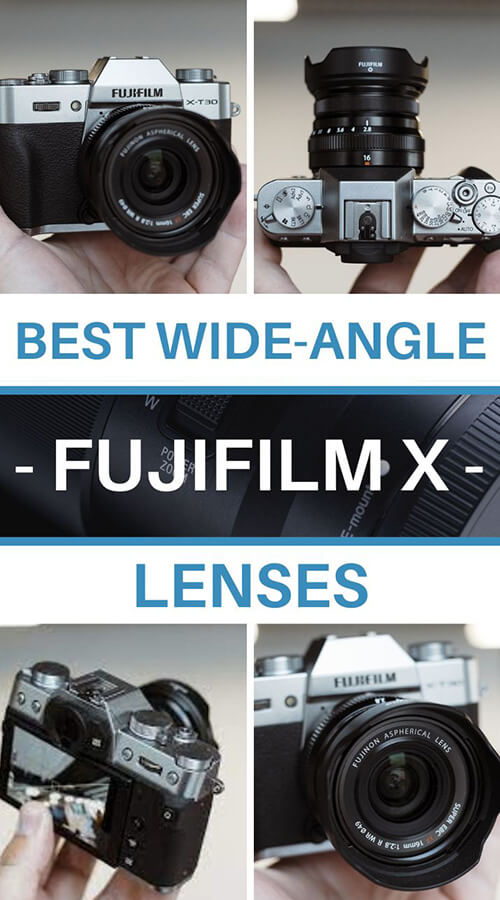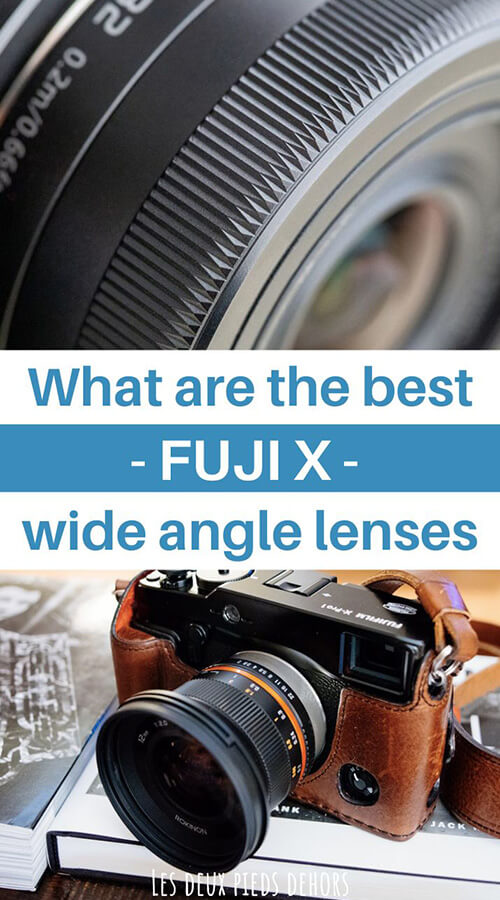Best Fujifilm wide-angle lenses
Last update: 04/19/2024
Our blog continues to grow thanks to you, our readers. This blog may contain affiliate links, which means we can earn a small commission if you make a purchase through them, at no extra cost to you. This helps us to continue to bring you more and support our work!
In 2011, Fujifilm entered the mirrorless world by releasing their first X-mount cameras. In fact, you will find on our dedicated page all the available Fujifilm X lenses. Fujifilm was mostly known in the days of film, especially for its iconic films like Provia, Velvia and Neopan. They decided to continue with the APS-C format, the one they had tried to introduce DSLRs with, the FinePix, which were not very popular.
This article presents you the best Fujifilm wide-angle lenses currently available and which will make the most of the 26MP of the latest Fujifilm APS-C sensors, such as the X-T200, the X-T30, the X-T4 and the X-Pro. We have in fact detailed in an article all the current Fujifilm X cameras, and we try our best to guide you in your choice.
Wide-angle lenses are very popular among landscape and architecture photographers, where we like to be able to capture the immensity of a scene, but also in reportage when we lack distance. If you wish, I recommend you to read our article giving the best tips to shoot landscapes.
If you’re more of a street photographer, I’ve just put together a comprehensive guide to choosing one of the famous lightweight, compact and smaller pancake lenses for the Fuji X mount.
If you’re in the Fujifilm world, don’t hesitate to check out our comprehensive guide on Fujifilm macro lenses!
23/10/2023
- Addition of the Fujinon XF 8mm f/3.5 WR Ultra Wide Angle Fixed Lens, a very interesting prime lens for shooting at a wide angle.
02/21/2024
- Addition of the Tamron 11-20mm f/2.8 Di III-A RXD X, un very good value for money if you’re looking for a great ultra wide-angle lens
Which Fuji wide-angle lenses should I choose? What can I recommend?
The Fujinon XF 8mm f/3.5 WR stands out for its compactness and lightness, ideal for outdoor shoots with all-weather construction. The Tamron 11-20mm f/2.8 Di III-A RXD offers remarkable versatility with a constant aperture of f/2.8, perfect for quality images even in low light. For superior image quality, the Fujinon XF 18mm f/1.4 R LM WR is unbeatable with its large aperture and fast, quiet autofocus, suited for dynamic reportage.
For photographers looking for an affordable option without sacrificing quality, the Fujinon XF 16mm f/2.8 R WR is an excellent choice. It offers a good balance between performance and budget, especially suited for those just starting to explore wide-angle photography. On the other hand, the Viltrox AF 13mm f/1.4 XF, although slightly more expensive, impresses with its large f/1.4 aperture, ideal for low-light conditions and achieving beautiful bokeh, thus providing a viable alternative to more costly lenses.
Best Wide-Angle Lenses for X-Mount Cameras: Detailed Overview
Here are what I consider as the best wide-angle lenses from Fujifilm at the moment. I will update this article as soon as a new lens of this type deserves to be there.
To summarize, here is a table with the main features to remember for each lens mentioned below.
So here are the best Fuji X wide-angle lenses in my opinion:
- Fujinon XF 8mm f/3.5 WR
- Tamron 11-20mm f/2.8 Di III-A RXD X
- Fujinon XF 18mm f/1.4 R LM WR
- Sigma DC DN Contemporary 16mm f/1.4
- Fujinon XF 8-16mm f/2.8 R LM WR
- Fujinon XF 16mm f/2.8 R WR
- Fujinon XF 10-24mm f/4 R OIS WR
- Samyang AF 12mm f/2 Fuji X
- Viltrox AF 13mm f/1.4 XF
Detailed characteristics of every lens are summarized in the table below.
Fujinon XF 8mm f/3.5 WR
| Features | Visual |
|---|---|
| 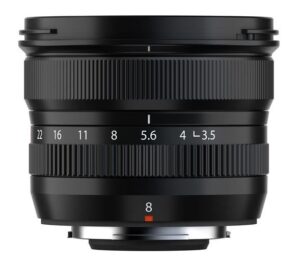 |
Introduced in June 2023, the Fujinon XF 8mm f/3.5 WR offers a unique option for the X-mount, serving as a compact ultra-wide-angle lens (equivalent to 12mm on a full-frame camera). Weighing in at just 215g and measuring just 68mm x 52.8mm, it offers significant advantages over the alternative (Fujinon XF 8-16mm f/2.8 R LM WR), which is four times heavier despite offering a wider field of view.
Despite its light weight, the construction of the Fuji XF 8mm is remarkable. It consists of 12 elements arranged in 9 groups (including 3 aspherical lenses and 2 low dispersion lenses). Ideal for outdoor use, the lens has an aperture ring and is weatherproof. Although the autofocus is less crucial for a wide-angle lens, it is still fast and of a high quality. The lens does not have image stabilization.
The lens has a diameter of 62 mm and a minimum focusing distance of 18 cm. The lens is well made, with a matte black finish and comes with a petal-shaped lens hood. It should be noted that there is no switch on the barrel. Image quality is excellent at full aperture in the centre, dropping slightly towards the edges and extremities. When you close the aperture, the sharpness improves slightly and the quality is maintained throughout the image at f/5.6. Optical flaws such as vignetting and distortion are present. However, software corrections are available. Chromatic aberrations are kept to a minimum.
In conclusion, the Fujinon XF 8mm F3.5 WR is still an excellent choice for wide-angle photography, offering a lightweight option. In my opinion, what you have here is a high quality lens at a price that is still reasonable.

Tamron 11-20mm f/2.8 Di III-A RXD X
| Features | Visual |
|---|---|
| 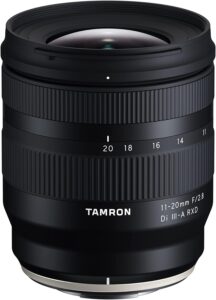 |
Already available in the Sony E-mount since June 2021, Tamron released its ultra-wide-angle zoom lens, the Tamron 11-20mm f/2.8 Di III-A RXD in the X-mount in mid-2023. This lens is a bit of a game-changer when it comes out, and gives Fujifilm users a new, reasonably priced option for a light, ultra-wide-angle zoom lens. The only other options are the Fujinon XF 8-16mm f/2.8 R LM WR, which is much bigger, heavier and more expensive. And the Fujinon XF 10-24mm f/4 R OIS WR, which is generally not as good or as bright.
The Tamron 11-20mm RXD, which accepts 67mm filters, is compact (8.6cm long) and lightweight (335g), making it ideal for using with Fuji X bodies. In addition, it has a very solid construction, is resistant to moisture and has a fluorine coating. With no adjustment buttons, the exterior design is uncluttered. The lens does not have an aperture ring. The autofocus is described as being generally good and quiet. Depending on the focal length, the lens has a minimum focusing distance of 15 to 23 cm. Even at the wide angle, it is possible to create a nice bokeh effect at the full aperture when you are close to your subject.
In terms of image quality, the lens remains at the top of its class, with very good sharpness in the center and at full aperture, while the edges and corners are a “little” soft. Closing the aperture to f/4 and then to f/5.6 produces an excellent, sharp, smooth image. Optical flaws such as vignetting and distortion are present, but are well controlled. Chromatic aberrations are low, but flare resistance is average.
In conclusion, the Tamron 11-20mm f/2.8 Di III-A RXD X is a very welcome ultra-wide-angle lens from Fuji, with solid quality, very good optical performance and bright optics. In our opinion, it still represents excellent value for money!

Fujinon XF 18mm f/1.4 R LM WR
| Features | Visual |
|---|---|
| 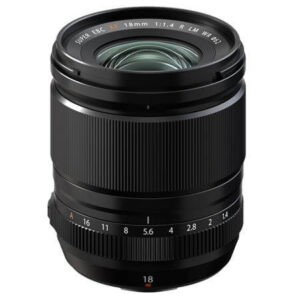 |
In April 2021, Fujifilm released this 18mm f/1.4, close to the 16mm f/1.4 and equivalent to a 27mm on full frame sensor. Nikon and Sigma had in the past released 28mm f/1.4 on DSLR, and many smartphones and compact experts offer this type of focal length.
While the 16mm f/1.4 is getting old and shows its flaws on the latest cameras, this 18mm offers a very high level of image quality that gets even better from f/2. Moreover, it has a high-end all-weather construction and a very fast and quiet AF. In addition, it is relatively light, compact and has a very large maximum aperture. If the focal length is a bit long for a wide-angle lens, it will work well for reportage and won’t disappoint you if you like this type of lens.
Of course, such a bright and high-end lens is not cheap as you will have to pay more than 900€. But you will have the best Fujifilm has to offer.
Sigma DC DN Contemporary 16mm f/1.4
| Features | Visual |
|---|---|
|  |
Early 2022, Sigma finally entered the X-mount market by offering 3 lenses. They already released the Sony E-mount and Canon M. Among these 3 lenses is the 16mm f/1.4 Contemporary.
Compared to the Fujifilm version, the Sigma is privileged by the fact that it is more recent, and was indeed conceived to exploit the faster AF of the Sony APS-C cameras. As a result, it manages to deliver better image quality, becoming excellent from f/2 and exceptional around f/5.6. The lower build quality than the Fujinon and the absence of an aperture ring, cherished by Fuji users, are still compensated by the half price and a better reactivity.
For 430€, you will have a 16mm lens, which is a bit big and heavy, but much cheaper and with a better image quality than the Fujinon version.

Fujinon XF 8-16mm f/2.8 R LM WR
| Features | Visual |
|---|---|
|  |
At the end of 2018, a new X-mount zoom lens came out. It is this 8-16mm with an f/2.8 aperture, a zoom lens that was missing from the Fujifilm lens lineup.
Although the shorter focal lengths struggle, especially at full aperture, it is capable of competing with the best prime lenses between 12 and 16mm. Its build quality is outstanding, like most Fujifinon WR, and its AF is fast and quiet. It is however not really appropriate for Astrophotography because of the important coma.
As a professional zoom, it comes with a price tag of almost 1900€. If some people think that it is less than 12-24 and 14-24mm f/2.8 in full frame, we have to admit that it is still very high and that many APS-C users appreciate this format to have lighter and cheaper lenses, which is not the case for this lens.
Fujinon XF 16mm f/2.8 R WR
| Features | Visual |
|---|---|
|  |
In early 2019, Fujifilm decided to offer a less bright and more affordable version than the f/1.4 version. A good option for those who are not looking for very large apertures.
If the image quality is not excellent at full aperture, it is already very good and improves quickly from f/4. The build quality is very good, and its physical characteristics make it a very pleasant lens to take to the field, like the DSLR 24mm f/2.8.
For less than 400€, which is less than half of the f/1.4 version, we have a less bright lens, but very practical.
Fujinon XF 10-24mm f/4 R OIS WR
| Features | Visual |
|---|---|
|  |
At the end of 2020, Fujifilm decided to renew its 10-24mm f/4 to add all-weather construction and more efficient stabilization.
If the 8-16mm was more struggling at the shorter focal lengths, this 10-24 is on the longer ones, especially at the edges. At short focal lengths, it is very good at full aperture. The build quality is excellent and the stabilization is very effective, a plus for Fujifilm cameras that do not have a stabilization on the sensor, like the X-T30 or X-T3. The maximum aperture is even smaller than the 8-16mm and 16mm prime lenses, but the focal range is very appropriate for many situations. The AF is fast and precise.
For almost 1000€, this 15-36mm equivalent offers very good possibilities with its all-weather construction and stabilization.

Samyang AF 12mm f/2 Fuji X
| Features | Visual |
|---|---|
|  |
In November 2021, Samyang decided to release its new Fuji X APS-C wide-angle lens with AF: the 12mm f/2. I wanted to mention this because there is an older version with manual focus.
The edges of the image are not very sharp and require closing the diaphragm to reach a high level, but the center is very good from the full aperture, the image being really homogeneous around f/8. The build quality is very good and the AF is fast and quiet.
Available for less than 500€, this lens delivers a more than correct image quality and a large maximum aperture.

Viltrox AF 13mm f/1.4 XF
| Features | Visual |
|---|---|
|  |
At the beginning of 2022, Viltrox added a lens to its APS-C range and offered this 13mm in the Fujifilm X-mount. This is the widest angle, brightest lens with AF available in APS-C.
The image quality is not very homogeneous in the center and, like most Viltrox, the lens suffers from flare and chromatic aberrations. When closing the aperture, we reach a very good level, but we wonder why we should buy an f/1.4 lens if it is only to shoot at f/5.6 or f/8… The construction is quite good and it even has an aperture ring. However, its AF can be unreliable, especially in video.
For more than 450€, we can wonder if the Samyang mentioned before would not be more interesting given its weight and its more reasonable dimensions as well as its all-weather construction.
Here are the main characteristics of the above mentioned lenses in a table.
| Fujifilm wide angle lens | Focal length | Max. aperture | Filter | D/L | Weight | Min. focus distance | All-weather construction | Stab. | Best Price |
|---|---|---|---|---|---|---|---|---|---|
| Fujinon XF 8mm f/3.5 WR | 8mm | f/3.5 | 62mm | 68 x 53 mm | 215g | 17cm | YES | NO | Amazon B&H |
| Tamron 11-20mm f/2.8 Di III-A RXD X | 11-20mm | f/2.8 | 67mm | 73 x 86 mm | 335g | 15-23cm | YES | NO | Amazon B&H |
| Fujinon XF 18mm f/1.4 R LM WR | 18mm | f/1.4 | 62mm | 69 x 76mm | 370g | 20cm | YES | NO | Amazon B&H |
| Sigma DC DN Contemporary 16mm f/1.4 | 16mm | f/1.4 | 67mm | 72.2 x 92.3mm | 405g | 25cm | NO | NO | Amazon B&H |
| Fujinon XF 8-16mm f/2.8 R LM WR | 8-16mm | f/2.8 | Non | 121.5 x 88mm | 805g | 25cm | YES | NO | Amazon B&H |
| Fujinon XF 16mm f/2.8 R WR | 16mm | f/2.8 | 49mm | 45.4 x 60mm | 155g | 17cm | YES | NO | Amazon B&H |
| Fujinon XF 10-24mm f/4 R OIS WR | 10-24mm | f/4 | 72mm | 87 x 78mm | 410g | 24cm | YES | YES | Amazon B&H |
| Samyang AF 12mm f/2 Fuji X | 12mm | f/2 | 62mm | 70 x 59.2mm | 223g | 20cm | YES | NO | Amazon B&H |
| Viltrox AF 13mm f/1.4 XF | 13mm | f/1.4 | 67mm | 90 x 74mm | 420g | 22cm | NO | NO | Amazon B&H |
Wide-angle alternatives for Fujifilm X
There are a few other wide-angle lenses with AF in X-mount, mostly Fujinon, listed here :
- The Zeiss 12mm f/2.8 Touit, released in 2013, has aged quite well but still costs over 900€. If its performances are still very good, its noisy AF and its price seem to me too high compared to the lenses listed above, notably the 12mm f/2 Samyang or even the 10-24mm f/4 Fujinon.
- The Fujinon XF 14mm f/2.8 R, released about ten years ago, is beginning to age badly, its price still being above 800€. For this price, you can find much better even if you have to accept a slightly different focal length like the 12mm f/2 Samyang or the 16mm f/2.8 Fujifilm.
- The Fujinon XF 16mm f/1.4 R WR which has an all-weather construction and a good image quality, but the recently released Sigma version offers a little better for less money. Unless you’re an absolute fan of the Fujifilm aperture ring and design, which is understandable, the Sigma seems to me a better choice until Fujifilm renews it.
- The Fujinon XF 18mm f/2 R, also released about ten years ago, did not bear the weight of the years any better than the 14mm. For less money, as it is still above 500€, the 16mm f/2.8 is again a better option.
If you are willing to consider manual focus lenses, some third party brands offer alternatives, but I would recommend AF lenses, especially since some of them were designed for full frame in the first place, like the 14mm f/2.8 Samyang. After all, a lens with AF can work in manual, but the opposite is not true. Nevertheless, here are some of those options:
| Lens | Max. aperture | Filter | Best Price |
|---|---|---|---|
| Laowa 9mm f/2.8 Zero-D | f/2.8 | 49mm | Amazon B&H |
| Samyang 10mm f/2.8 ED AS NCS CS | f/2.8 | Non | Amazon B&H |
| Samyang 12mm f/2 NCS CS | f/2 | 67mm | Amazon B&H |
| 7Artisans 12mm f/2.8 | f/2.8 | Non | Amazon B&H |
| Meike 12mm f/2.8 | f/2.8 | 72mm | Amazon B&H |
| Samyang 14mm f/2.8 ED AS IF UMC | f/2.8 | Non | Amazon B&H |
| Samyang 16mm f/2 ED AS UMC CS | f/2 | 77mm | Amazon B&H |
| Samyang 20mm f/1.8 ED AS UMC | f/1.8 | 77mm | Amazon B&H |
You can find all the manual lenses in the link summarizing all the lenses for the X-mount.
Some reminders to choose your wide-angle lens
The focal length
For landscape and architecture photography, focal lengths around 13mm (20mm equivalent in FF) are quite popular. This type of lens is often a victim of strong distortions, but the cameras and software will be able to correct this defect quite often. Be careful, however, some lenses (like most of the manual lenses indicated in the previous chapter) do not communicate with the camera and will therefore not be able to benefit from it. You will thus have to do everything manually by software.
In general, lenses with a focal length below 13mm are very hard to manufacture and their quality will be less good. These focal lengths are, moreover, more difficult to use and require experience and know-how. Indeed, you cover a very large field of view and disturbing elements will quickly disturb your composition while the important elements will be drowned in the mass. In other words, you risk having so much information in the image that it will become too overcrowded.
Feel free to read our article on focal length in photography to go into a little more detail.
Maximum aperture
Except in Astrophotography or in very low light situations (situations described in part in this article), this type of lens does not often benefit from large apertures since we will regularly try to maximize the depth of field on one side, and therefore close the diaphragm, and on the other side, even at large apertures, we will not be able to easily reduce the depth of field enough to enjoy a nice foreground/background blur.
It will be better, except for special uses, to have a lens offering a smaller max. aperture, more homogeneous and possibly equipped with stabilization (not difficult, only the Fujinon 10-24mm f/4 has it !). However, for focal lengths beyond 14mm (equivalent to 21mm in FF), reportage conditions where this type of focal length can often be appreciated will benefit a little more from a large aperture, like wedding photography.
We present to you the interest of a large aperture in our dedicated article.
Construction quality
For landscape photography and travel, especially in places where the climate can be harsh, it will be interesting to choose lenses with an all-weather construction. This will ensure that your equipment can withstand the elements, your camera needs an all-weather body like the X-T3 or X-T4.
Don’t get hung up on it, though: lenses that don’t have 45 seals will often be able to handle complicated conditions. In many cases, it’s not even your equipment that will make the decision, but you, who want to go out with or without your camera, while a huge storm is kicking up cows and destroying houses outside!
Filters
In many cases, it will be interesting to use filters like polarizers or ND/GND filters. In these cases, it will be useful to have lenses that accept screw-in filters. There are of course filter holders, but they are usually expensive and large, which means that they will take up space and time to install.
We detail in a full article everything you need to know about camera lens filters (choice, differences, criteria, etc.).
Conclusion
That’s it, we’ve come to the end of this article which I hope will help you in your choice if you’re looking for a wide-angle lens for your Fujifilm X-mount camera.
Do not hesitate to give us any feedback on these lenses if you own one, or to let us know if others have not been mentioned.
In the meantime, I also invite you to read our detailed guide on the best lenses for Fujifilm X including different focal lengths (standard, macro, telephoto, etc.)
See you soon for a new Fuji article!

Written by Sylvain PONS
I've been passionate about photography since 2010, learning as I went along. Today, I dedicate myself to guiding others in their choice of camera gear and sharing a variety of tips to improve their photography skills.
Despite our care, a mistake may have slipped into this article. If you find any, please don't hesitate to let us know so we can correct it as soon as possible and keep our information up-to-date!

